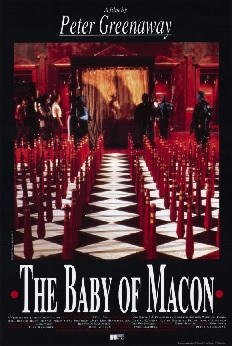Peter Greenaway: The Baby of Mâcon

The Baby of Mâcon poster. Licensed under Fair use via Wikipedia.
There’s film, and there’s film by Peter Greenaway.
I’ve been a fan of this extraordinary film maker from the first time I saw The Cook, the Thief, His Wife & Her Lover. So I was sligthly surprised when I found a new film directed by the master that I didn’t know about. The Baby of Mâcon is far from new, but not one of his most well known films. Released in 1993, it stired some controversy and was refused distribution in the USA. That pretty much sealed its fate as an underground classic.
As usual with Greenaway, the set and the filming is magnificent! The film is set in a 17th century italian theatre, and we follow a stageplay about corruption, desception and religious abuse and power. That is, we’re woven in and out of the play itself as well as the interaction with the audience and the actors themselves. A wealthy prince and his court is in the audience, but also takes part in the play. Sometimes as a commentators, sometimes directly taking part in the act itself. Also the line between the actors and their characters blurr as the story unfolds. All of this wrapped in a magnificent theatre set filled with religious ornaments, relics and an aura of sacredness.
“The men and the women does not play in their beds anymore. Copulation is serious business!”
While the set is beautiful, the plot is all but. The play takes us to the village of Mâcon where famine and drought have caused the animals to wither and the women to become infertile.
In the midst of this a baby is born by an old and ugly woman. A beautiful child that gives hope to the vilage that the bad times are ending.
The child is abused, first by his elder sister which sees the hope and desperation of the villagers as a source to enrich herself. She claims it’s her child born by virgin birth, and stages him as a divine creature that provides blessings to the villagers willing to pay the price. And indeed the village prospers and with it the power of the childs sister.
The story that unfolds is ugly and meant to challenge the viewer. It’s difficult to feel sympathy with anybody, and the level of corruption permeating every scene brings as much distaste as the scenery itself brings joy. This is where Peter Greenaway shines. By the way he portrays the people that could evoke some symapthy he makes the viewer an accomplice to the tragedy, because they are so unlikeable. Even the child itself, which at first appears an innocent victim of his sisters greed is at the end of it in some sort of control of the entire situation. Far from the innocent instrument from which others can enrich themselves.
The Baby of Mâcon is a film that can not be described. It has to be experienced.
